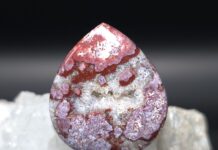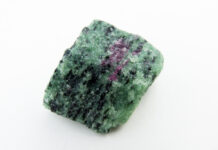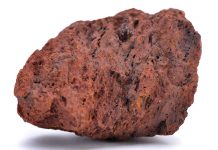
Rhyolite is an igneous rock that can be found across the globe. Its abundance and versatility have given it geological and archeological importance. The term “rhyolite” was first introduced by geologist Ferdinand Von Richthofen in 1860. It originated from the Greek word, rhyax, meaning a “stream of lava,” and lithos meaning “stone.”
How This Igneous Rock Forms
Rhyolite is formed through the cooling and solidification of molten magma or lava. It belongs to the family of felsic rocks, characterized by their high silica content. Rhyolite typically originates from highly explosive volcanic eruptions, where the magma is rich in silica. As the magma cools rapidly, rhyolite is formed. Interestingly, volcanic eruptions that produce obsidian, tuff and pumice all have similar compositions, just different cooling conditions. It rarely forms from oceanic eruptions.
When forming, rhyolite can contain small cavities caused by gas bubbles that are called vugs. After the newly formed rock cools, groundwater and other gases can seep into the vugs and precipitate. Depending on the mineral composition of the groundwater and gases, different gems like opal, red beryl, agate, topaz and jasper can be formed within the vugs.
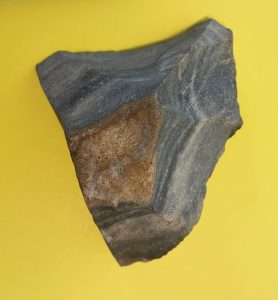
Identifying Rhyolite
Iron oxide minerals give this rock its colors, ranging from light gray to pink, red and dark brown. Because it cools rapidly during formation, it has a fine-grained texture made of small crystals that are not visible to the naked eye. They are easiest seen with a hand lens or in a magnified cross-section. Rhyolite may exhibit banding or spherical growth as well as radiating needle-like patterns. Its high silica content gives a glassy appearance. This glassy texture can be observed in freshly broken surfaces, presenting a smooth and reflective surface. Rhyolite (Mohs scale of Hardness – 6) commonly contains mineral crystals of quartz, plagioclase, sanidine, feldspar and biotite, sometimes appearing as small specks within the rock.
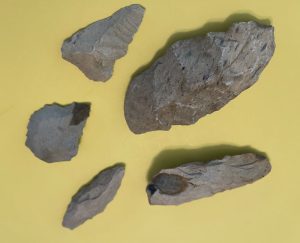
Locations Worldwide
Deposits are found worldwide in various geological settings, including in England, Wales, Europe, Asia, India, Iceland, Australia, New Zealand and China. It commonly occurs in areas with extensive volcanic activity, such as volcanic arcs, rift zones and continental hotspots. Rhyolite volcanoes include household names such as Mount Kilimanjaro in Africa, the Yellowstone Caldera in Wyoming and Crater Lake in Oregon.
Throughout fields across the southeastern United States, some landowners and farmers discover flakes of rock seasonally as they turn over the soil for spring plantings. “If you follow the plow,” one farmer suggested, “you can probably find evidence of rhyolite as it becomes unearthed under layers of soil.” The long-time camouflaged rock sometimes reveals flakes, even ancient tools, some broken and others intact and carved, while others may be notched. Along the eastern coast, it is common to find arrow points, spear points scrapers and other carvings fashioned out of rhyolite.

Ancient Uses and Traditions
Abundant rhyolite was first used by prehistoric and ancient natives. Native Americans discovered the versatility of rhyolite as they fractured and easily flaked this rock into a variety of useful forms. Because of its popularity with carvers, rhyolite became an important trading tool between native tribes.
A further glimpse into history reveals rhyolite was knapped or shaped typically by striking it with a large rock, such as a hammerstone, to reduce and form tools or weapons. As time passed, carvers discovered they could remove a piece of the rock by fashioning it via percussion or pressure, carving it as a tool for agricultural purposes. Some tied the formed rock to the end of a stick, creating a hoe-like appearance. Other tools were fashioned by creating and inventing new uses for rhyolite, some being notched and others unnotched, depending on the use and type of tools that were created. Flakes, struck from larger rocks, had very sharp edges, making them useful for cutting, scraping and carving. Over time, some flakes were formed into projectile points to use with a bow when hunting for food.
Modern Uses of Rhyolite
As a useful rock, rhyolite has endured through the Modern Age, growing in both scale and scope. It is mined and processed for certain types of commercial construction, including roads and walls. It is also used for kitchen pots and pans.

Vuggy material is used for jewelry. It can also be formed and fashioned into garden accents such as rock borders and small carvings. This rock can also be used as a hoe, a spade or a trowel after being fashioned. Hunters can use it as scrapers, knives and other instruments.
Rhyolite is also used for spiritual practices. It is believed to possess strong metaphysical connections to the earth. Its metaphysical properties can be described as a balancing stone, recommended to increase self-worth and help resolve personal challenges. This rock is believed to help achieve human goals as the crystals within the rock strengthen the soul, body and mind.
Just as early man discovered and fashioned the many uses of rhyolite, scientists, researchers, hunters and collectors continue to research the possibilities of further uses for this versatile rock.
This story previously appeared in Rock & Gem magazine. Click here to subscribe. Story by Anita B. Stone.



